3 The Process of Science in Biology
By the end of this section, you will be able to do the following:
- Identify the shared characteristics of the natural sciences
- Summarize the steps of the scientific method
- Compare inductive reasoning with deductive reasoning
- Describe the goals of basic science and applied science

What is biology? In simple terms, biology is the study of living organisms and their interactions with one another and their environments. This is a very broad definition because the scope of biology is vast. Biologists may study anything from the microscopic or submicroscopic view of a cell to ecosystems and the whole living planet (Figure 1). Listening to the daily news, you will quickly realize how many aspects of biology we discuss every day. For example, recent news topics include Escherichia coli (Figure 2) outbreaks in spinach and Salmonella contamination in peanut butter. Other subjects include efforts toward finding a cure for AIDS, Alzheimer’s disease, and cancer. On a global scale, many researchers are committed to finding ways to protect the planet, solve environmental issues, and reduce the effects of climate change. All of these diverse endeavors are related to different facets of the discipline of biology.

The Process of Science
Biology is a science, but what exactly is science? What does the study of biology share with other scientific disciplines? We can define science (from the Latin scientia, meaning “knowledge”) as the knowledge that covers general truths or the operation of general laws, especially when acquired and tested by the scientific method. It becomes clear from this definition that applying the scientific method plays a major role in science. The scientific method is a method of research with defined steps that include experiments and careful observation.
We will examine the scientific method steps in detail later, but one of the most important aspects of this method is the testing of hypotheses by means of repeatable experiments. A hypothesis is a suggested explanation for an event, that is both testable and falsifiable. Although using the scientific method is inherent to science, it is inadequate in determining what science is. This is because it is relatively easy to apply the scientific method to disciplines such as physics and chemistry, but when it comes to disciplines like archaeology, psychology, and geology, the scientific method becomes less applicable as repeating experiments becomes more difficult.
These areas of study are still sciences, however. Consider archaeology—even though one cannot perform repeatable experiments, hypotheses may still be supported. For instance, an archaeologist can hypothesize that an ancient culture existed based on finding a piece of pottery. He or she could make further hypotheses about various characteristics of this culture, which could be correct or false through continued support or contradictions from other findings.
It can take a while before a hypothesis becomes proven and widely accepted by the scientific community. In general, scientists attribute different degrees of confidence in scientific evidence-based the quality or quantity of the research and data supporting a given conclusion. Some scientists, especially in medicine, have codified these different sources of information into a hierarchy of scientific evidence (Figure 3) [1].
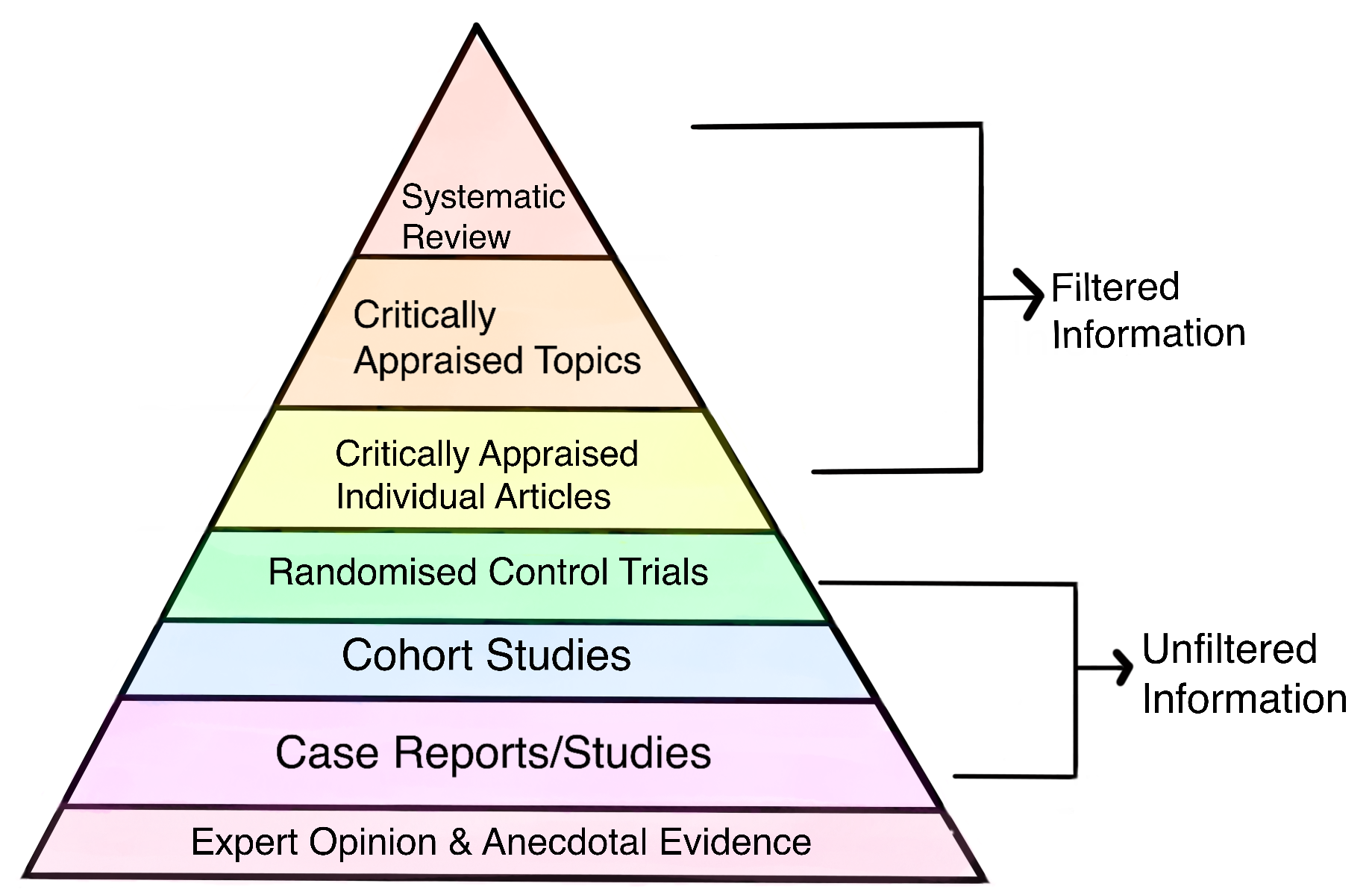
With enough evidence, a concept or explanation can become the highest form of scientific understanding: a theory.
What Is a Scientific Theory?
A scientific theory [2] is a broad explanation of events that is widely accepted by the scientific community. To become a theory, an explanation must be strongly supported by a great deal of evidence.
People commonly use the word theory to describe a guess or hunch about how or why something happens. For example, you might say, “I think a woodchuck dug this hole in the ground, but it’s just a theory.” Using the word theory in this way is different from the way it is used in science. A scientific theory is not just a guess or hunch that may or may not be true. In science, a theory is an explanation that has a high likelihood of being correct because it is so well supported by evidence.
What is a scientific theory?
Natural Sciences
What would you expect to see in a museum of natural sciences? Frogs? Plants? Dinosaur skeletons? Exhibits about how the brain functions? A planetarium? Gems and minerals? Maybe all of the above? Science includes such diverse fields as astronomy, biology, computer sciences, geology, logic, physics, chemistry, and mathematics (Figure 4). However, scientists consider those fields of science related to the physical world and its phenomena and processes in natural sciences. Thus, a museum of natural sciences might contain any of the items listed above.
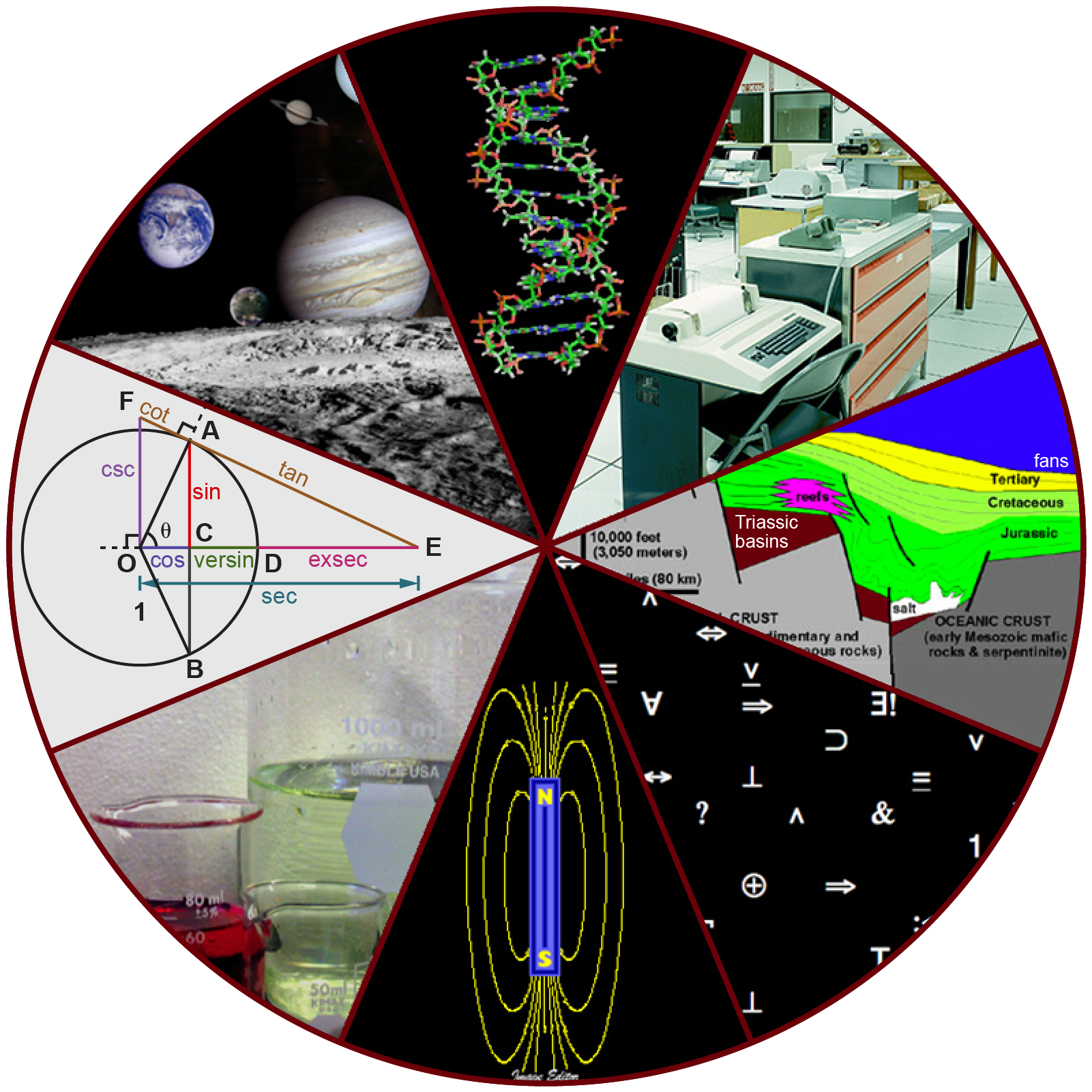
There is no complete agreement when it comes to defining what the natural sciences include, however. For some experts, the natural sciences are astronomy, biology, chemistry, earth science, and physics. Other scholars choose to divide natural sciences into life sciences, which study living things and include biology, and physical sciences, which study nonliving matter and include astronomy, geology, physics, and chemistry. Some disciplines such as biophysics and biochemistry build on life and physical sciences and are interdisciplinary. Some refer to natural sciences as “hard science” because they rely on the use of quantitative data. Social sciences that study society and human behavior are more likely to use qualitative assessments to drive investigations and findings.
Not surprisingly, the natural science of biology has many branches or subdisciplines. Cell biologists study cell structure and function, while biologists who study anatomy investigate the structure of an entire organism. Those biologists studying physiology, however, focus on the internal functioning of an organism. Some areas of biology focus on only particular types of living things. For example, botanists explore plants, while zoologists specialize in animals.
Scientific Reasoning
One thing is common to all forms of science: an ultimate goal is “to know.” Curiosity and inquiry are the driving forces for the development of science. Scientists seek to understand the world and the way it operates. To do this, they use two methods of logical thinking: inductive reasoning and deductive reasoning.
Inductive reasoning is a form of logical thinking that uses related observations to arrive at a general conclusion. This type of reasoning is common in descriptive science. A life scientist such as a biologist makes observations and records them. These data can be qualitative or quantitative, and one can supplement the raw data with drawings, pictures, photos, or videos. From many observations, the scientist can infer conclusions (inductions) based on evidence. Inductive reasoning involves formulating generalizations inferred from careful observation and analyzing a large amount of data. Brain studies provide an example. In this type of research, scientists observe many live brains while people are engaged in a specific activity, such as viewing images of food. The scientist then predicts the part of the brain that “lights up” during this activity to be the part controlling the response to the selected stimulus, in this case, images of food. Excess absorption of radioactive sugar derivatives by active areas of the brain causes the various areas to “light up”. Scientists use a scanner to observe the resultant increase in radioactivity. Then, researchers can stimulate that part of the brain to see if similar responses result.
Deductive reasoning or deduction is the type of logic used in hypothesis-based science. In deductive reasoning, the pattern of thinking moves in the opposite direction as compared to inductive reasoning. Deductive reasoning is a form of logical thinking that uses a general principle or law to forecast specific results. From those general principles, a scientist can extrapolate and predict the specific results that would be valid as long as the general principles are valid. Studies in climate change can illustrate this type of reasoning. For example, scientists may predict that if the climate becomes warmer in a particular region, then the distribution of plants and animals should change.
Both types of logical thinking are related to the two main pathways of scientific study: descriptive science and hypothesis-based science. Descriptive (or discovery) science, which is usually inductive, aims to observe, explore, and discover, while hypothesis-based science, which is usually deductive, begins with a specific question or problem and a potential answer or solution that one can test. The boundary between these two forms of study is often blurred, and most scientific endeavors combine both approaches. The fuzzy boundary becomes apparent when thinking about how easily observation can lead to specific questions. For example, a gentleman in the 1940s observed that the burr seeds that stuck to his clothes and his dog’s fur had a tiny hook structure. On closer inspection, he discovered that the burrs’ gripping device was more reliable than a zipper. He eventually experimented to find the best material that acted similarly and produced the hook-and-loop fastener popularly known today as Velcro. Descriptive science and hypothesis-based science are in continuous dialogue.
The Scientific Method
Biologists study the living world by posing questions about it and seeking science-based responses. Known as the scientific method, this approach is common to other sciences as well. The scientific method was used even in ancient times, but England’s Sir Francis Bacon (1561–1626) first documented it (Figure 5). He set up inductive methods for scientific inquiry. The scientific method is not used only by biologists; researchers from almost all fields of study can apply it as a logical, rational problem-solving method.

The scientific process typically starts with an observation (often a problem to solve) that leads to a question. Let’s think about a simple problem that starts with an observation and apply the scientific method to solve the problem. One Monday morning, a student arrives at class and quickly discovers that the classroom is too warm. That is an observation that also describes a problem: the classroom is too warm. The student then asks a question: “Why is the classroom so warm?”
Proposing a Hypothesis
Recall that a hypothesis is a suggested explanation that can be tested and falsified. A good hypothesis is specific and includes clear variables that can be measured. For a given question, one can propose several hypotheses.
Let’s consider an example. You notice the classroom you teach in is warmer than usual. One hypothesis might be, “The temperature of the classroom is warmer because no one turned on the air conditioning.” Alternatively, a second hypothesis might be, “The temperature in the classroom is warmer because there is a power failure, and so the air conditioning doesn’t work.” While the cause is the same–no air conditioning–the variables are different: the air conditioner status (on/off) versus the power supply (present/absent). To find a solution, you need to isolate the problem.
The example above might seem simplistic–trouble-shooting an HVAC is not science… right? In fact, it is science or at least one part of the scientific process. And it illustrates the generality of scientific thinking in humans. Science is simply a methodology for problem-solving and collecting knowledge. It’s not the only system of knowledge or even the best per se, but it is one we regularly employ in our daily lives without even realizing it.
Once you have selected a hypothesis, you can make a prediction. A prediction is similar to a hypothesis but it typically has the format “If . . . then . . . .” For example, the prediction for the first hypothesis might be, “If you turn on the air conditioning, then the classroom will no longer be too warm.” Note how this relates to the testability and falsifiability of the original hypothesis. You are testing the hypothesis by flipping the air conditioner switch. If you switch it on, and nothing happens, then the hypothesis is falsified, and it’s time to call an electrician to test the second hypothesis.
Testing a Hypothesis
To test a hypothesis, researchers design an experiment or analysis designed to validate or reject the hypothesis. In addition to the original hypothesis, researchers typically identify a null hypothesis. A null hypothesis represents the expectation if the proposed explanation is wrong. In our example from above, the competing null hypothesis would be “the power failure and loss of air conditioning does not cause the room to be warm.”
There are many types of experiments and analyses researchers conduct to test hypotheses. The general structure of most of these experiments or analyses, however, involves examining the effect of one variable on another. A variable is any part of the experiment that can vary or change during the course of the experiment. The variable of interest is referred to as the dependent variable. In our example, the dependent variable would be the temperature of the classroom. The independent variable is the condition the researcher purposefully changes to see how it affected the dependent variable. In our example, the independent variable would be the status of the air conditioner. Variables other than the independent variable that might nonetheless affect the dependent variable are referred to as confounding factors. A well-designed experiment will attempt to minimize the effect of confounding factors so that the researcher can be confident that the independent variable is the one causing the change in the dependent variable. It is not always possible to eliminate every confounding factor in a single experiment, however, and researchers must often run multiple experiments to ensure that something other than what they think is going on is actually occurring.
The most basic experimental design involves two groups, a control group and an experimental group. The control group represents the unmanipulated study condition, while the experimental group is somehow manipulated to test the effect of the independent variable. Otherwise, differences between the groups are limited to reduce any potential confounding variables. If the experimental group’s results differ from the control group, the difference must be due to the hypothesized manipulation, rather than some outside factor. If the groups do not differ, then the independent variable has no effect, and the null hypothesis would be supported.
Look for the variables and controls in the examples that follow. To test the first hypothesis, the student would find out if the air conditioning is on. If the air conditioning is turned on but does not work, there should be another reason, and the student should reject this hypothesis. To test the second hypothesis, the student could check if the lights in the classroom are functional. If so, there is no power failure and the student should reject this hypothesis. The students should test each hypothesis by carrying out appropriate experiments. Be aware that rejecting one hypothesis does not determine whether or not one can accept the other hypotheses. It simply eliminates one hypothesis that is not valid (Figure 5). Using the scientific method, the student rejects hypotheses that are inconsistent with experimental data.
While this “warm classroom” example is based on observational results, other hypotheses and experiments might have clearer controls. For instance, a student might attend class on Monday and realize she had difficulty concentrating on the lecture. One observation to explain this occurrence might be, “When I eat breakfast before class, I am better able to pay attention.” The student could then design an experiment with a control to test this hypothesis.
To determine if the results of their experiment are significant, researchers use a variety of statistical analyses. Statistical analyses help researchers determine whether the observations from their experiments are meaningful or due to random chance. For example, if a researcher observes a difference between the control group and experimental group, should they treat it as a real effect of the independent variable or simply random chance? A result is considered to have statistical significance when it is very unlikely to have occurred given the null hypothesis. Statistical results themselves are not entirely objective and can depend on many assumptions including the null hypothesis itself. A researcher must consider potential biases in their analyses, just as they do confounding variables in their experimental design. Two factors that play a major role in the power of an experiment to detect meaningful statistical differences are sample size and replication. Sample size refers to the number of observations within each treatment, while replication refers to the number of repeated times the same experiment treatment is tried. In general, the bigger the sample size and the more replication, the more confidence a researcher can have in the outcome of their study.
In hypothesis-based science, researchers predict specific results from a general premise. We call this type of reasoning deductive reasoning: deduction proceeds from the general to the particular. However, the reverse of the process is also possible: sometimes, scientists reach a general conclusion from a number of specific observations. We call this type of reasoning inductive reasoning, and it proceeds from the particular to the general. Researchers often use inductive and deductive reasoning in tandem to advance scientific knowledge.
VISUAL CONNECTION
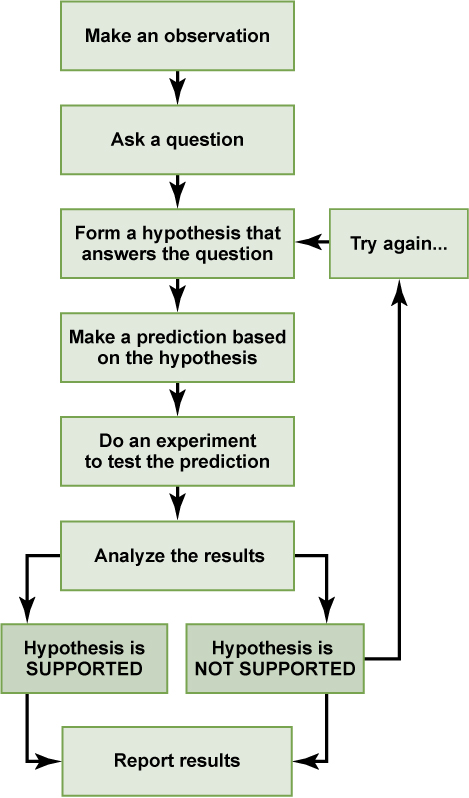
In the example below, the scientific method is used to solve an everyday problem. Order the scientific method steps (numbered items) with the process of solving the everyday problem (lettered items). Based on the results of the experiment, is the hypothesis correct? If it is incorrect, propose some alternative hypotheses.
| 1. Observation | a. There is something wrong with the electrical outlet. |
| 2. Question | b. If something is wrong with the outlet, my coffee maker also won’t work when plugged into it. |
| 3. Hypothesis (proposed answer) | c. My toaster doesn’t toast my bread. |
| 4. Prediction | d. I plug my coffee maker into the outlet. |
| 5. Experiment | e. My coffee maker works. |
| 6. Result | f. Why doesn’t my toaster work? |
Answer:
1: C; 2: F; 3: A; 4: B; 5: D; 6: E. The original hypothesis is incorrect, as the coffee maker works when plugged into the outlet. Alternative hypotheses include that the toaster might be broken or that the toaster wasn’t turned on.
VISUAL CONNECTION
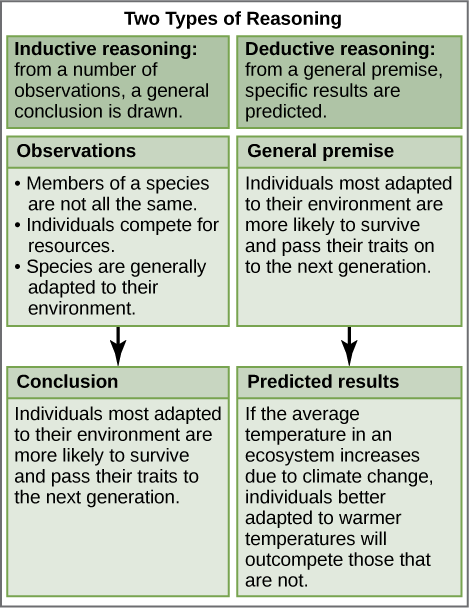
The scientific method may seem too rigid and structured. It is important to keep in mind that, although scientists often follow this sequence, there is flexibility. Sometimes an experiment leads to conclusions that favor a change in approach. Often, an experiment brings entirely new scientific questions to the puzzle. Many times, science does not operate in a linear fashion. Instead, scientists continually draw inferences and make generalizations, finding patterns as their research proceeds. Scientific reasoning is more complex than the scientific method alone suggests. Notice, too, that we can apply the scientific method to solving problems that aren’t necessarily scientific in nature.
Two Types of Science: Basic Science and Applied Science
The scientific community has been debating for the last few decades about the value of different types of science. Is it valuable to pursue science for the sake of simply gaining knowledge, or does scientific knowledge only have worth if we can apply it to solving a specific problem or to bettering our lives? This question focuses on the differences between two types of science: basic science and applied science.
Basic science or “pure” science seeks to expand knowledge regardless of the short-term application of that knowledge. It is not focused on developing a product or a service of immediate public or commercial value. The immediate goal of basic science is knowledge for knowledge’s sake, although this does not mean that, in the end, it may not result in a practical application.
In contrast, applied science or “technology,” aims to use science to solve real-world problems, making it possible, for example, to improve a crop yield, find a cure for a particular disease, or save animals threatened by a natural disaster (Figure 6). In applied science, the problem is usually defined for the researcher.
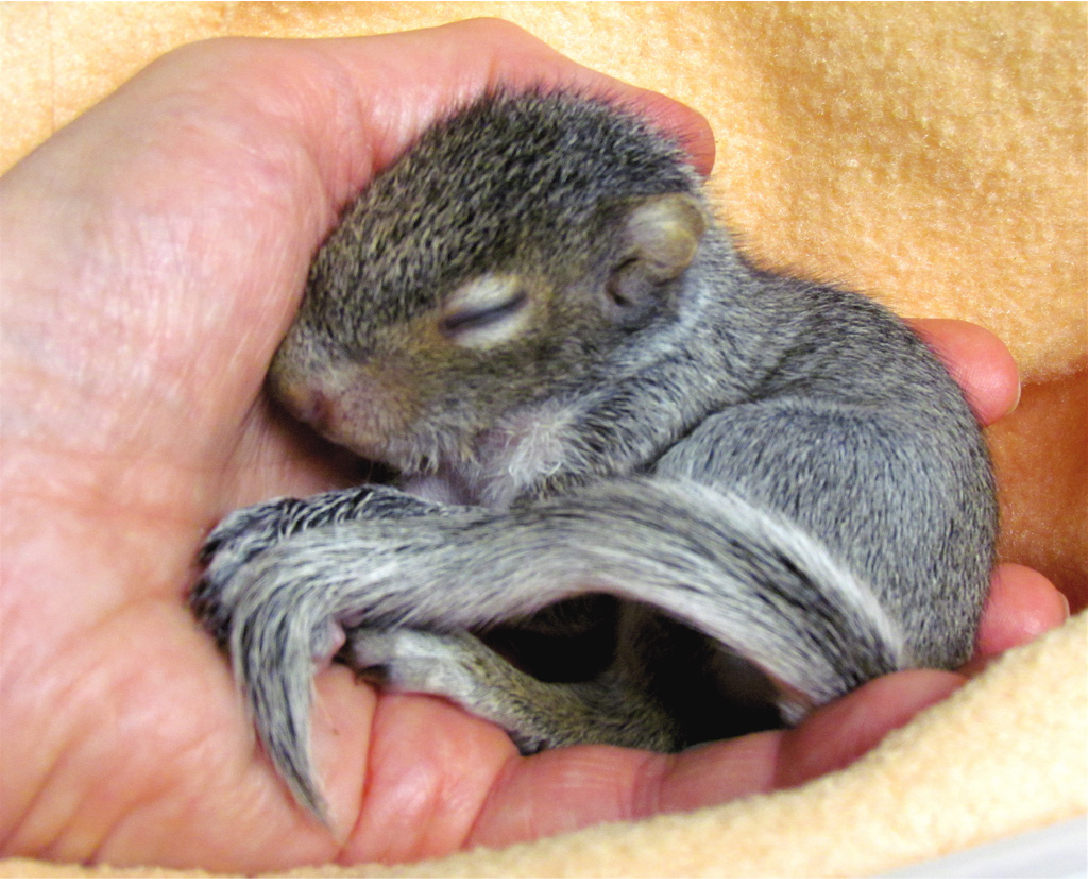
Some individuals may perceive applied science as “useful” and basic science as “useless.” A question these people might pose to a scientist advocating knowledge acquisition would be, “What for?” However, a careful look at the history of science reveals that basic knowledge has resulted in many remarkable applications of great value. Many scientists think that a basic understanding of science is necessary before researchers develop an application therefore, applied science relies on the results that researchers generate through basic science. Other scientists think that it is time to move on from basic science in order to find solutions to actual problems. Both approaches are valid. It is true that there are problems that demand immediate attention; however, scientists would find few solutions without the help of the wide knowledge foundation that basic science generates.
One example of how basic and applied science can work together to solve practical problems occurred after the discovery of DNA structure led to an understanding of the molecular mechanisms governing DNA replication. DNA strands, unique in every human, are in our cells, where they provide the instructions necessary for life. When DNA replicates, it produces new copies of itself, shortly before a cell divides. Understanding DNA replication mechanisms enabled scientists to develop laboratory techniques that researchers now use to identify genetic diseases, pinpoint individuals who were at a crime scene, and determine paternity. Without basic science, it is unlikely that applied science would exist.
Another example of the link between basic and applied research is the Human Genome Project, a study in which researchers analyzed and mapped each human chromosome to determine the precise sequence of DNA subunits and each gene’s exact location. (The gene is the basic unit of heredity. An individual’s complete collection of genes is his or her genome.) Researchers have studied other less complex organisms as part of this project in order to gain a better understanding of human chromosomes. The Human Genome Project (Figure 7) relied on basic research with simple organisms and, later, with the human genome. An important end goal eventually became using the data for applied research, seeking cures and early diagnoses for genetically related diseases.
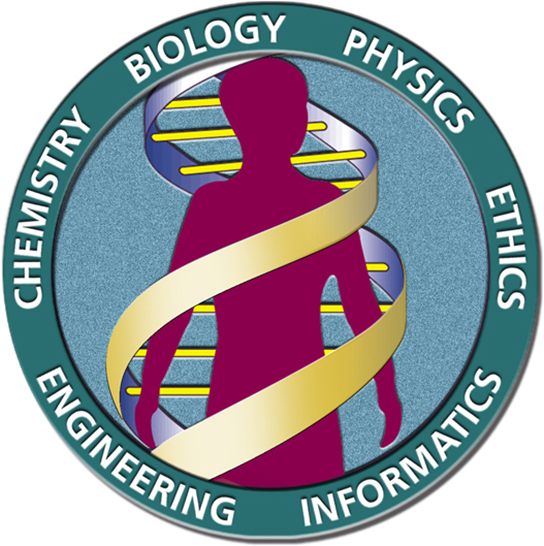
While scientists usually carefully plan research efforts in both basic science and applied science, note that some discoveries are made by serendipity, that is, by means of a fortunate accident or a lucky surprise. Scottish biologist Alexander Fleming discovered penicillin when he accidentally left a petri dish of Staphylococcus bacteria open. An unwanted mold grew on the dish, killing the bacteria. Fleming’s curiosity to investigate the reason behind the bacterial death, followed by his experiments, led to the discovery of the antibiotic penicillin, which is produced by the fungus Penicillium. Even in the highly organized world of science, luck—when combined with an observant, curious mind—can lead to unexpected breakthroughs.
Reporting Scientific Work
Whether scientific research is basic science or applied science, scientists must share their findings in order for other researchers to expand and build upon their discoveries. Collaboration with other scientists—when planning, conducting, and analyzing results—are all important for scientific research. For this reason, important aspects of a scientist’s work are communicating with peers and disseminating results to peers. Scientists can share results by presenting them at a scientific meeting or conference, but this approach can reach only the select few who are present. Instead, most scientists present their results in peer-reviewed manuscripts that are published in scientific journals. Peer-reviewed manuscripts are scientific papers that a scientist’s colleagues or peers review. These colleagues are qualified individuals, often experts in the same research area, who judge whether or not the scientist’s work is suitable for publication. The process of peer review helps to ensure that the research in a scientific paper or grant proposal is original, significant, logical, and thorough. Grant proposals, which are requests for research funding, are also subject to peer review. Scientists publish their work so other scientists can reproduce their experiments under similar or different conditions to expand on the findings. The experimental results must be consistent with the findings of other scientists.
A scientific paper is very different from creative writing. Although creativity is required to design experiments, there are fixed guidelines when it comes to presenting scientific results. First, scientific writing must be brief, concise, and accurate. A scientific paper needs to be succinct but detailed enough to allow peers to reproduce the experiments.
The scientific paper consists of several specific sections—introduction, materials and methods, results, and discussion. This structure is sometimes called the “IMRaD” format. There are usually acknowledgment and reference sections as well as an abstract (a concise summary) at the beginning of the paper. There might be additional sections depending on the type of paper and the journal where it will be published. For example, some review papers require an outline.
The introduction starts with brief, but broad, background information about what is known in the field. A good introduction also gives the rationale of the work. It justifies the work carried out and also briefly mentions the end of the paper, where the researcher will present the hypothesis or research question driving the research. The introduction refers to the published scientific work of others and therefore requires citations following the style of the journal. Using the work or ideas of others without proper citation is plagiarism.
The materials and methods section includes a complete and accurate description of the substances the researchers use and the methods and techniques they use to gather data. The description should be thorough enough to allow another researcher to repeat the experiment and obtain similar results, but it does not have to be verbose. This section will also include information on how the researchers made measurements and the types of calculations and statistical analyses they used to examine raw data. Although the materials and methods section gives an accurate description of the experiments, it does not discuss them.
Some journals require a results section followed by a discussion section, but it is more common to combine both. If the journal does not allow combining both sections, the results section simply narrates the findings without any further interpretation. The researchers present results with tables or graphs, but they do not present duplicate information. In the discussion section, the researchers will interpret the results, describe how variables may be related, and attempt to explain the observations. It is indispensable to conduct an extensive literature search to put the results in the context of previously published scientific research. Therefore, researchers include proper citations in this section as well.
Finally, the conclusion section summarizes the importance of the experimental findings. While the scientific paper almost certainly answers one or more scientific questions that the researchers stated, any good research should lead to more questions. Therefore, a well-done scientific paper allows the researchers and others to continue and expand on the findings.
Review articles do not follow the IMRAD format because they do not present original scientific findings or primary literature. Instead, they summarize and comment on findings that were published as primary literature and typically include extensive reference sections.
Review of the scientific process
Glossary
- abstract
- opening section of a scientific paper that summarizes the research and conclusions
- applied science
- form of science that aims to solve real-world problems
- basic science
- science that seeks to expand knowledge and understanding regardless of the short-term application of that knowledge
- biology
- the study of living organisms and their interactions with one another and their environments
- conclusion
- section of a scientific paper that summarizes the importance of the experimental findings
- control
- part of an experiment that does not change during the experiment
- deductive reasoning
- form of logical thinking that uses a general inclusive statement to forecast specific results
- descriptive science
- (also, discovery science) form of science that aims to observe, explore, and investigate
- discussion
- section of a scientific paper in which the author interprets experimental results, describes how variables may be related, and attempts to explain the phenomenon in question
- falsifiable
- able to be disproven by experimental results
- hypothesis
- suggested explanation for an observation, which one can test
- hypothesis-based science
- form of science that begins with a specific question and potential testable answers
- inductive reasoning
- form of logical thinking that uses related observations to arrive at a general conclusion
- introduction
- opening section of a scientific paper, which provides background information about what was known in the field prior to the research reported in the paper
- life science
- field of science, such as biology, that studies living things
- materials and methods
- section of a scientific paper that includes a complete description of the substances, methods, and techniques that the researchers used to gather data
- natural science
- field of science that is related to the physical world and its phenomena and processes
- peer-reviewed manuscript
- scientific paper that a scientist’s colleagues review who are experts in the field of study
- physical science
- field of science, such as geology, astronomy, physics, and chemistry, that studies nonliving matter
- plagiarism
- using other people’s work or ideas without proper citation, creating the false impression that those are the author’s original ideas
- results
- section of a scientific paper in which the author narrates the experimental findings and presents relevant figures, pictures, diagrams, graphs, and tables, without any further interpretation
- review article
- paper that summarizes and comments on findings that were published as primary literature
- science
- knowledge that covers general truths or the operation of general laws, especially when acquired and tested by the scientific method
- scientific method
- method of research with defined steps that include observation, formulation of a hypothesis, testing, and confirming or falsifying the hypothesis
- serendipity
- fortunate accident or a lucky surprise
- theory
- tested and confirmed explanation for observations or phenomena
- variable
- part of an experiment that the experimenter can vary or change
Access for free at https://openstax.org/books/biology-2e/pages/1-introduction

